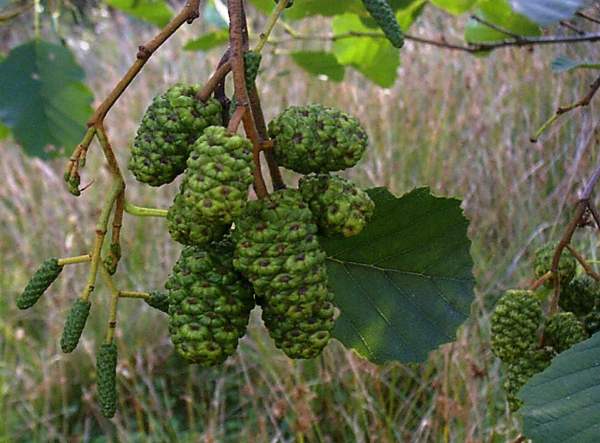Alnus glutinosa - Black Alder
Phylum: Magnoliophyta - Class: Magnoliopsida - Order: Sapindales - Family: Betulaceae

Black Alders are a familiar sight along riverbanks. They thrive on waterlogged soil and their roots help to limit erosion during heavy spates (high, fast flowing water). In the past alders were coppiced and the wood used to make charcoal for drawing and as a filtration medium. Until the mid 1940s alder charcoal was also used in making gunpowder.

Grey Alder was introduced from mainland Europe in the late 1700s. In the 1990s, the fungus Phytophthora alni, a relative of the fungal blight that attacks potato crops, infested many of the riverside alders of southern England and Wales. Thousands of mature trees have been lost as a result.
An early sign is brownish patches appearing on the lower trunk. (Healthy trunks have rough bark that is much the same colour all over.)
The alder catkins (male and female flowers that occur on the same tree) form in the autumn. They turn from green to brown during the winter, and pollination occurs in the following spring.

Alder leaves
The leaves are initially sticky with hair on the underside (unlike Hazel, which has hairs on both sides of its leaves). Another diagnostic feature is that alder leaves are generally smaller and usually a darker shade of green than those of Hazel, with which they are sometimes confused.

Male and female flowers
Shown in the picture above right are male (slender) catkins on the left of the picture and female (much more rounded) on the right). The catkins form during early autumn (which is when this picture was taken) and pollination occurs in the following spring.
Fungi associated with Alder trees
In alder carr woodland (overgrown fen, swamp and bog), many of the trees have their feet in water throughout the year. This is not good habitat for large fungi. In drier places, however, there is a range of ectomycorrhizal (EM) fungi specifically or commonly found with alders; one of these is Paxillus rubicundulus, a close relative of the Brown Rollrim, Paxillus involutus (and just as poisonous).
The wood-rotting fungus Pholiota alnicola is commonly known as the Alder Scalycap, because it is nearly always found on fallen alder trunks and branches in damp places. (This mushroom is far from common and only very rarely is it seen fruiting on willows and birches.) As if in compensation, the Blushing Bracket, Daedaleopsis confragosa, which is most often seen on willow trunks does can be seen occasionally on dead or dying alders.